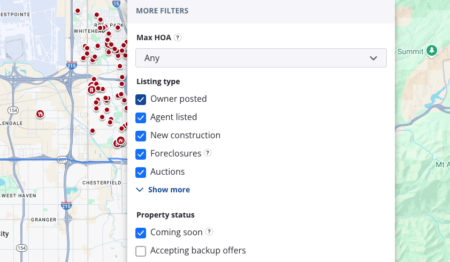Bigger. Better. Bolder. Inman Connect is heading to San Diego. Join thousands of real estate pros, connect with the Inman Community and gain insights from hundreds of leading minds shaping the industry. If you’re ready to grow your business and invest in yourself, this is where you need to be. Go BIG in San Diego!
Four years after complying with the National Association of Realtors’ no-commingling rule, Zillow is quietly reversing course to once again allow the display of non-MLS listings alongside other properties on the platform after previously obscuring them with a filter many users never knew existed.
In markets where local multiple listing services never enacted NAR’s rule — or recently rescinded it — users of the country’s largest search portal will now see more properties in their search prompts by default, including for-sale by-owner listings, non-MLS auctions and buildable floor plans, executives told Inman.
NAR has long defended the policy and repeatedly rebuffed efforts to eliminate it.
TAKE THE INMAN INTEL SURVEY FOR APRIL
“We’re excited that a growing number of MLSs are adopting policies that allow for commingled display, enabling us to provide a more complete and seamless experience for consumers,” Zillow said in a statement to Inman. “The majority of major metro areas are now seeing the single search experience, and we’re continuing to work with MLSs across the country to expand that coverage.”
The update was subtle and made discreetly, beginning in December, Zillow executives told Inman exclusively. But it followed years of advocacy and appeals Zillow made directly to the National Association of Realtors, the industry and the broader public in opinion pieces, interviews and paid advertisements.
Zillow’s two-tabbed user experience requires users to know about, find and change a filter to see for-sale by-owner and other listings. Many users didn’t know the filter exists.
The change hinges on the National Association of Realtors’ no-commingling rule, an optional rule created back when brokers began entering listings online in the 1990s. Since then, it has become a focal point for industry players including Zillow — and regulators like the U.S. Department of Justice, which has said the policy may be anticompetitive.

Matt Hendricks | Zillow
“Zillow has long advocated against the no-commingling rule,” Matt Hendricks, Zillow’s vice president of industry affairs, told Inman. “Consumers want and expect a single-search experience, where all available homes for sale can be viewed seamlessly. We applaud the many MLSs that have revoked the no-commingling restriction, and we’re excited about enhancing the search experience to reflect this progress as we expand single search on a by-market basis.”
The two-tabbed display
The update is the latest in Zillow’s journey from becoming the portal with the largest set of monthly users to joining hundreds of MLSs to gain access to all listing data via IDX feeds and complying with NAR’s no-commingling rule.

Errol Samuelson | Zillow
In January 2021, Zillow updated its platform to comply with the rule nationwide. Doing so involved creating a two-tabbed user experience. Listings that came from the MLS were the default view users saw. To see non-MLS listings like FSBOs, which made up 6 percent of homes sold last year, users needed to know about, find and change a filter.
While it complied with the rule by creating a two-tabbed system on its website, Zillow continued to advocate against the rule, asking NAR to rescind the rule on four separate occasions, Chief Industry Development Officer Errol Samuelson said.
“There’s no need for it, and we think it reduces consumer transparency,” Samuelson told Inman in November. “Now, we’re seeing others out there who agree with us that it’s time for the rule to go.”
During the four years that Zillow adhered to the rule universally, listings that complied with the no-commingling rule were what users saw by default. If they wanted to scroll non-MLS listings, users would have to click a tab labeled “Other Listings,” and adjust their settings to see non-MLS listings.
REX v. Zillow
The change resulted in plummeting pageviews for non-MLS listings, critics said, in part because users thought they were already seeing all listings in a single-search display by default.
The change was so effective at hiding non-MLS listings that discount brokerage REX filed a lawsuit in March 2021 targeting Zillow’s compliance with the rule, and it wound down its residential brokerage business the next year and blamed NAR’s rule and Zillow’s decision to follow it for its demise. (REX would later lose the case and an attempt to appeal the loss.)
Amid the lawsuit, Zillow called on REX to join it in advocating for the elimination of the rule. An attorney for REX didn’t respond to a request for comment on Zillow’s policy change.
The rule has also drawn the attention of the U.S. Justice Department. In testimony given by a DOJ attorney during the REX case in February, the department questioned whether the rule was truly optional and suggested it was anticompetitive.
In a statement, NAR defended the no-commingling rule and pointed to court rulings against REX in the case as evidence the rule is fair.
“The United States Court of Appeals for the Ninth Circuit affirmed a decision of the district court emphasizing what we’ve said from day one — NAR’s no-commingling rule never constituted an antitrust violation,” NAR said in a statement. “The rule is optional, leaving MLSs the choice whether to adopt it, and, in fact, 29 percent of them chose not to.”
Nonetheless, some of the nation’s largest MLSs have recently updated their rules to rescind the no-commingling rule for their users, including Bright MLS in May 2024 and Stellar MLS in October.

Zillow’s updated single search user experience shows FSBO and other listings by default, without requiring users to update their settings.
“We’ve supported commingling property data on IDX-licensed websites since the IDX program was invented decades ago, and we expanded that support in May 2024 to include commingling at the website operator’s discretion as long as our MLS-sourced property information may be filtered by the user,” Bright MLS said in a statement to Inman.
REColorado is credited as being the first MLS to rescind the no-commingling Rule when it did so in 2022.

James Dwiggins | NextHome
Zillow said it needed time to make updates to its systems to avoid degrading the user experience. It didn’t make any announcements about the policy change because it is still rolling out the changes as more and more MLSs adjust their policies. And it said it was still working in more markets to be able to move to a single-search experience.
Others questioned whether the portal’s update would have any meaningful impact on agents’ lives and businesses.
“I don’t personally have an issue with it,” NextHome CEO James Dwiggins said. “If we’re worried about FSBOs on a website, then we have a lot bigger problems as an industry to worry about.”
Email Taylor Anderson




